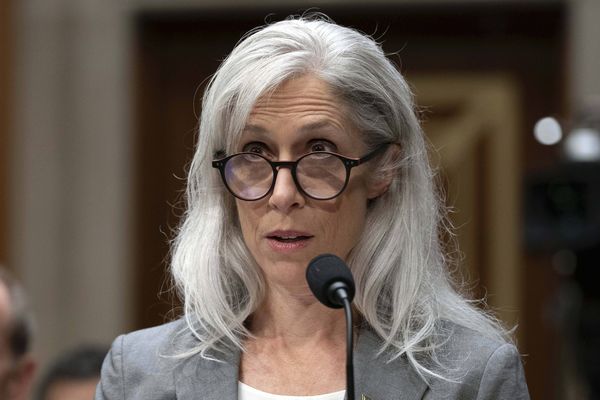
For a long time, the dot painting has been synonymous with Aboriginal art. Emerging out of the remote Northern Territory community of Papunya in the early 1970s, the first dot paintings were produced when art teacher Geoffrey Bardon encouraged his Indigenous students to paint their stories in murals on the school wall.
But long before that, circles and dots were used in ceremonies in the form of body paint or marks on the ground. The Papunya people drew on this knowledge in their art, painting stories, ceremonies and rituals, first on walls and then on canvas and board.
dot, dot, dot […], a new exhibition at Sydney College of the Arts, tackles some of the issues around the use of Papunya dots in paintings, but also looks at why so many artists – Indigenous and non-Indigenous – are attracted to using dots in their work.
Curator Janelle Evans, a lecturer at Sydney University, a Wingara Mura fellow and Dharug artist, told Guardian Australia that the exhibition had its genesis in 2006, when she conducted an interview with Australian artist and political activist, Richard Bell. “He was talking about Aboriginal art as something constructed by the art market. So dot paintings are associated with Aboriginal art in the eyes of the global art market and it locks out people not doing dot painting.”
The ubiquity of the dot painting was so powerful that Indigenous artists working in different mediums had trouble attracting the interest of the international art market. At the same time, the market became flooded with cheap fakes and rip offs, alongside mass-produced tack such as tea towels made overseas and sold to tourists.

Even high fashion has come under fire for appropriating Indigenous motifs and cultural artefacts. Recently, French fashion brand Chanel received significant criticism for manufacturing a $2,000 boomerang.
Janelle Evans says the Chanel boomerang is “just another form of imperialism and colonialism done without thinking. The same thing is being done with the tourism market, where Aboriginal designs and materials are being made overseas without permission.”
In situations like this, Indigenous people rarely see the profits of their artefacts being used, perpetuating a cycle of poverty and appropriation.
Queensland MP Bob Katter has taken up the cause, putting a private member’s bill before parliament that seeks to amend consumer law to ensure that profits from Indigenous art and artefacts go back to Indigenous communities.

Katter told the ABC in May that a member of his team had recently visited souvenir shops in Cairns and found “something like 80 to 95% of the items there that claimed to be Indigenous were, in fact, imported and mass-produced”. Almost none of the profits were being returned to the communities.
Traditional owners and Indigenous artists addressed the Cairns Indigenous Art Fair last Friday seeking assurances from the prime minister that Indigenous art sold would be subject to a code of ethics. The code would be enshrined in consumer law and would ensure that artists received an income stream for their work and designs.
Evans says that things have started to shift on the dot-painting stereotype in the decade or so. There has been “a push to have urban, Indigenous artists accepted. As a result, the art market’s understanding of Indigenous art has expanded to include urban artists who work in many different mediums.”
Multimedia and photography are increasingly gaining a profile. Last year the National Gallery of Victoria opened a major exhibition, Who’s Afraid of Colour?, focusing on the work of Indigenous women. Not confined to dot painting, it also included less conventional works like painted skateboards and dilly bags made from scrap metal.
But what about artists using the dot who are non-Indigenous? It could be seen as cultural appropriation, although Evans says it’s not that clear cut.

“Non-Indigenous artists who work with dots can work without appropriation. Within the dot, there’s a whole world that can be created. Artists have always referred to other artists in their work but appropriation becomes an issue when you are copying someone’s style. You need to bring your own inquiry to into what you are doing.”
dot, dot, dot […] features the work of 10 artists and includes photography, painting, sculpture, screen and print media, “with each artist using the dot as a starting point to reflect on their own identity and beliefs”.
It focuses on showing work from artists who interpret the dot beyond the style of central and western desert artists and “in ways that are non-derivative,” says Evans.
“Appropriation is just another form of colonisation,” says Evans. “You are appropriating something from people that have had everything taken from them. The land has been taken. The language has been taken. The children have been taken. All that’s left is art.”
• dot, dot, dot […] is showing at SCA Galleries, Sydney College of the Arts, until 29 July







